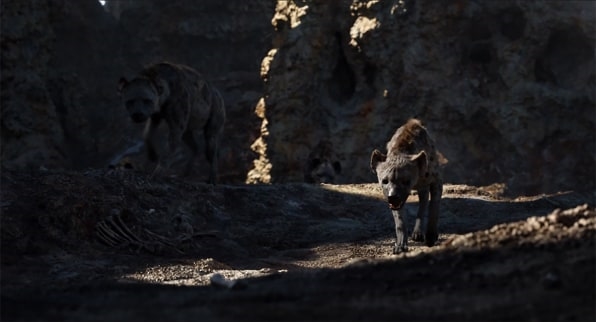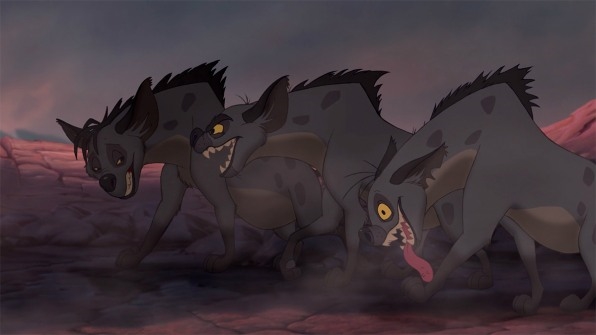In case you went 25 years without a spoiler: there was a stampede. Mufasa didn’t make it out.
Most scenes in the newly released “live-action” Lion King are direct re-creations from the original 1994 animated film—from the heartbreaking death of the king right down to smaller moments, like Scar’s terrorizing of a mouse in the opening act. Some critics have called it a shot-for-shot remake.
But one aspect that is decidedly not a carbon copy of the animated version? The hyenas.

The Lion King was met with near universal praise when it came out 25 years ago. It grossed 312.9 million in the U.S. It won two Oscars. But an argument nevertheless emerged concerning the two main hyenas, Shenzi and Banzai—namely, that they were racist characters. In an overwhelmingly white voice cast (for a movie about Africa), they were brought to life by minority actors, Whoopi Goldberg and Cheech Marin, who played them as low-life gangsters, reprobates who speak in slang and live tucked away in a shadowy corner of the Pride Lands—the wrong side of the tracks.
Critics said their accents instantly demonized the characters. Academic pieces blasted the hyenas’ “street” vernacular. Some articles pointed out how the clever, cunning Scar—who speaks with white British actor Jeremy Irons’ King’s English—subjugates the destitute hyenas as his servants. “The good-for-nothing hyenas are urban blacks,” wrote a Harvard psychologist. A New York Times journalist dubbed them “Sambo-ish.” When asked about the controversy in 1994, Disney spokeswoman Terry Press dismissed it. “It’s a story. It’s fiction,” she said. “These people need to get a life.”
Disney didn’t reply to my request to comment on the new hyenas, but judging from how different they are in the new version, it would appear someone at the studio took the controversy seriously enough to not repeat the same mistakes. This time around, the only white voice actors in the cast play periphery, comic characters: John Oliver as Zazu, Seth Rogen as Pumbaa, and Billy Eichner as Timon. It’s Donald Glover and Beyoncé (not Matthew Broderick and Moira Kelly) who lead the pack as leonine nobility.
Perhaps suggesting more about my subpar wokeness than anything else, I hadn’t thought of the problematic nature even two weeks ago, let alone when I first saw the animated film as a 6-year-old–even though I’d considered the gamut of other Lion King themes and theories. I’d long ago learned about its roots in Hamlet (the “Circle of Life” as the Elizabethan natural order; Simba’s hubris in “I Just Can’t Wait to Be King”; his hesitation in avenging his father’s death because, you know, “Hakuna Matata”). I’d grasped the hidden motifs, like the hyenas marching as malevolently as Nazis to Scar’s Hitler in a scene inspired by The Triumph of the Will.
But I’d never considered the notion of racism. I spoke to Dan Hassler-Forest, a professor of cultural studies at the University of Utrecht, who recently penned a piece in The Washington Post that argues that The Lion King as a fascistic story. (“Because I’m a horrible person who’s incapable of experiencing joy” is how he tweeted out the op-ed.) He weighed in on hyenagate, agreeing that the critters are coded as ethnic and social minorities, not only in their accents but also in their skin color, which he points out is darker than the hides of real hyenas.
“Simba and Nala’s first encounter with them is staged in a way that is familiar to most viewers in which naïve, innocent white kids stray into the ‘bad’ part of town and encounter dangerous gang members,” Hassler-Forest said. (Young Simba was voiced by Jonathan Taylor Thomas, a white actor, but young Nala was played by an African-American actress, Niketa Calame.)
He added: “The three prominent hyenas fit neatly into notoriously stereotypical depictions of black, Hispanic, and mentally disabled depictions of the lower-class residents of ghettos.”
That last part, by the way, refers to Ed. Poor Ed. Hyena number three is the only one that was voiced by a white actor, Jim Cummings—although “voiced” is a stretch. Ed doesn’t talk but rather cackles and snickers and hysterically spasms. Six-year-old me did not make the association with a mental illness like Tourette’s, and saw him merely as the essence of the laughing hyena.
This year, Ed is now Azizi, which is Swahili for “precious.” He’s voiced by Eric André. Banzai, the middle hyena with a questionable Japanese name originally voiced by Marin, is now Kamari, meaning “moonlight,” and is voiced by Keegan Michael-Key. Azizi not only talks in this version, but he’s almost on a smarts par with Kamari. These creatures are still a comedic force, but they are not the butt of an ongoing racist joke.
The comedy stems from the sharpness of their dialogue but not the fast talk we remember from the animated film. There’s no “cub sandwich” or “cactus butt.” They’re too shrewd to even follow a grieving Simba into the cactus bush, which led to slapstick laughs at their expense in 1994. Physical comedy is practically nonexistent. We don’t even get the birdy boiler.
While he didn’t directly mention any of the controversy in an appearance earlier this month on The Tonight Show, Key joked to Jimmy Fallon that he’d wanted to secure his role as the middle hyena and not the guffawing Ed. “I’m a black man,” he said. “I’m trying not to play crack addicts anymore. I’m trying to uplift.”

Of course, Disney has a history of unequivocally racist content. In Dumbo, there’s a crow that’s actually named Jim Crow. The Song of the South presents a rosy, harmonious portrait of the Antebellum South. Even 1992’s Aladdin was deemed racist—”but hey, it’s Disney,” sarcastically shrugged The Times.
Disney has admitted to these past offenses but has never confessed to racism in The Lion King. Perhaps a quiet hyena update was shrewder, so as not to tarnish the reputation of what is, to my generation (and especially to superfan Chance the Rapper), a cherished and beloved tale and which still holds up as a personal all-time favorite film.
The new cast and crew has acknowledged the hyena revision, but diplomatically, of course, chalking it up to the newly realistic nature of the animals. In Disney press notes for the new film, director Jon Favreau is quoted as saying, “The hyenas had to change a lot. Because of the photo-real nature of the film, having too broad of a comedic take on the hyenas felt inconsistent with what we were doing.”
While Kamari and Azizi still provide the laughs, the overwhelming effect is one of danger. “We wanted to raise the stakes with Shenzi,” Favreau said. The third hyena, Shenzi, is now played by Florence Kasumba, who has described her character as a threatening force. That’s true: Unlike Goldberg’s Shenzi, the source of much of the idiomatic humor, she’s menacing and even has her own face-off with Nala in the fiery climax, while Simba and Scar are locking claws. “Those hyenas were funny,” she says in the press notes. “These hyenas are dangerous.”
Favreau also explains in the Disney materials that he decided to tone down Scar’s villainous number, “Be Prepared,” because of the heightened realism of his movie. There’s no marching, for starters. Jorgen Klubien, an animator who created the scene in the 1994 movie that recalls Triumph of the Will, guessed the changes were made to eliminate the caricatures. As for rethinking it because of the racist assertions? “Nonsense,” he argued.
There’s a noticeably different power balance, too. These hyenas are wilier and warier of Scar. This time, Shenzi faces Scar early on, threatening to eat him. They’re presented to the audience as Scar’s equals. During the number, the hyenas are literally staged on the same level as the great villain until the very end, after he’s won their allegiance, when he climbs the precipice.
Rather than belittle them, he panders. “My vision is clear and wide-ranging / And even encompasses you,” the subdued song goes. That’s a far cry from—and truthfully more monotonous than—the delightfully evil original number, where he intimidates, calling them “crude” and “thick,” scoffing with his gravelly vocals that “It’s clear from your vacant expressions / The lights are not all on upstairs.” Their “powers of retention,” he sings gruffly, “are as wet as a warthog’s backside.”
For Hassler-Forest, the professor, the hyena clean-up is ineffective. The class distinction—which is his real qualm with the 1994 movie—still remains. In the new version, he argues, the hyenas stay as “societal outcasts who contribute nothing and feed off the wealth created by others.”
As for the racism, Favreau did paw away any signs of lingering stereotypes, even if that improvement comes at the expense of dulling the hyenas down. Sure, they provide some of the rare comedic relief in the film, but it’s just not enough. Once laughed at, the hyenas are laughing now.
Sadly, we’re not.
(126)